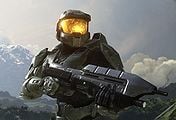List of references to Greek mythology in the Halo series
From Halopedia, the Halo wiki
Many names of locations, vehicles, ships and operations have been taken from the Greek mythology. Below are some examples of them:
- Tartarus: Tartarus was named after the worst, most cruel part of the Underworld, where the original Cyclopes and Hekatonkheires were sealed by their Titan parents, and later the Titans themselves became inhabitants of Tartarus. The worst people and things were said to go to Tartarus for eternal torture.
- Déjà: One of the lessons Déjà taught involved the famous Greek Battle of Thermopylae. Déjà took on the appearance of an ancient Greek goddess, and although which one is not specified, she seems to look like Athena, the goddess of wisdom and war.
- Iris: In Greek mythology, Iris was a minor god of the rainbow and the messenger of the gods, like Hermes.
- Operation: PROMETHEUS: This operation was named after Prometheus, a Titan who stole fire from god Zeus and gave it to mortals. He was subsequently punished by Zeus and his brother Poisedon, the kings of Olympus by being forced to endure his liver being pecked out in the mornings by the vulture Ethon, having it regrown, and then pecked out again the next day. Also, 300 Spartan-IIIs fought in this battle and died; this is much like the Battle of Thermopylae, were 300 Spartan soldiers fought the Persians. At this battle, all of the Spartans died fighting but also put a heavy lose on the Persians losing many soldiers. This is like the Covenant losing all their ships during Operation: PROMETHEUS.
- Sparta: The Spartan-I's, Spartan-II's and Spartan-III's were named after the Spartan warriors who originated in a city-state in the southern part of ancient Greece. The city-state retained the superior military power in the region between 650 and 363 B.C. Its citizens were following the simplest way of life as possible. They were all exercised, and their children, like the Halo SPARTANS, were trained from a very young age for many years.
- Leonidas: In the Delta Halo Suite of the Halo 2: Original Soundtrack, is a track called "Leonidas". Leonidas was a Spartan king from around 488 B.C. to 480 B.C. He died during the Battle of Thermopylae.
- Chiron: Chiron TL-34, a multiplayer map from Halo: Combat Evolved, is named after a Centaur who trained Heracles.
- Cyclops: The Cyclops is a UNSC unit available in Halo Wars, named after a group of mythical giants with only one eye in the middle of their head. Some were descendants of the Titans, while another was the son of Poseidon. Odysseus, while returning to his homeland, was captured by Cyclops on their island. He used his intelligence to get out, saving his friends from them.
- The Elephants on Sandtrap have the words Leviathan and Behemoth printed on their sides. Both are mythological creatures, with their names rooted in the Greek language, though not from Greek mythology.
- Heracles: The only surviving warship to survive the UNSC's first Naval encounter with the Covenant was a Destroyer named the UNSC Heracles. Hercules was a a divine hero, the son of Zeus and Alcmene, nephew of Amphitryon, who is most famous for doing the Labours of Heracles.[1]
- Archimedes: A Remote Scanning Outpost found at the edge of the Sigma Octanus system. In Greek history, Archimedes was a philosopher, mathematician and inventor.
- Arcadia: An important human colony, Arcadia might have taken its name from Arcadia, a region in Peloponnesus, south Greece.
- Melissa: Melissa, is the Greek word for bee. Considering the fact that the AI Melissa is afraid of bees, we can say that her name is inspired by the insect melissa.
- Movements of the Odyssey: The Movements of the Odysseys were a collection of 4 songs included in the Halo 2 Soundtrack. Odyssey is a ancient Greek novel written by Homer. It talks about the adventures of Odysseus since he left the Battle of Troy until he reached Ithaca, his homeland.
- Kurt Ambrose: Kurt-051's surname, Ambrose, comes from the Greek word Ambrosia (Αμβροσία). Ambrosia is the drink the immortal Gods of ancient Greece enjoyed to drink, and the source of their power.
- Station Delphi: Station Delphi is a deep space construction platform. In Greek mythology, Delphi was an important religious center and a key city in Greece. The well-known Oracle of Delphi, is located in this town.
- Ichor: Ichor was used as the word for "blood" in the novel Halo: The Flood. Ichor was the blood of the gods of Olympus. Though they were immortal they could still bleed the golden blood Ichor.
- Pallas Athena: Pallas Athena was an AI that worked as a librian at the Boston Public Library. Athena, was the Greek goddess of Wisdom, Craft, and War. Pallas was her second name.
- Mount Erebus: Erebus was the Greek underworld palace were Hades lived.
- Hesiod: Hesiod is a gas giant inhabited by Insurrectionists mentioned in Halo: The Cole Protocol. The name of the planet is likely a reference to the early Greek poet and rhapsode Hesiod, whose writings serve as a major source on Greek mythology, farming techniques, archaic Greek astronomy and ancient time-keeping.
- Charybdis IX: Charybdis IX is a UNSC Colony World, that was the site of Human rebel activity, and later the site of the Battle of Charybdis IX during the Human-Covenant War. Charybdis was the daughter of Poseidon. Originally a sea-nymph, she was turned into a sea monster by Zeus, after angering him by stealing Heracles' cattle.
- Herodotus: UNSC Herodotus was a UNSC Destroyer that took part in the Battle of Sigma Octanus IV and was finally destroyed by a Covenant assault Carrier. In real life, Herodotus was a Greek historian.
Images
- Mr. Mohawk from HGN.PNG
The Brute Chieftain, Tartarus.
Chiron TL-34, in Halo: Combat Evolved.
- H3 Elephant Sharpened2.jpg
The UNSC's Behemoth-class Troop Transport
John-117, or Master Chief, a Spartan super soldier of the UNSC.
- Movie Concept 2.jpg
SPARTAN training on Reach.
- Spartans-never-die.jpg
Kurt-051, another Spartan super soldier, just before his death.

